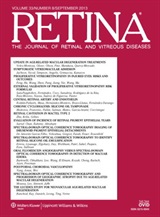Un ulteriore studio conferma l’efficacia dell’Aflibercept (Eylea) nel trattamento della maculopatia essudativa, anche dei casi resistenti al trattamento con Lucentis. Gli autori hanno riscontrato miglioramenti nell’essudazione, nel sollevamento dell’epitelio pigmentato (PED) e nell’acuità visiva passando dal Ranizumab (Lucentis) all’Aflibercept (Eylea).
Kumar, Nishant FRCOphth*,†; Marsiglia, Marcela MD, PhD*,‡,§; Mrejen, Sarah MD*; Fung, Adrian Tien-chin MBBS, MMed*; Slakter, Jason MD*,‡; Sorenson, John MD*,‡; Freund, K. Bailey MD*,‡,§
Retina
September 2013 – Volume 33 – Issue 8 – p 1605-1612
Purpose: To assess the efficacy of intravitreal aflibercept (2.0 mg) in patients with treatment-resistant neovascular age-related macular degeneration.
Methods: Retrospective analysis of eyes treated with aflibercept with persistent subretinal and/or intraretinal fluid despite previous treatments with intravitreal ranibizumab (0.5 mg). All patients were switched to intravitreal aflibercept (2.0 mg) and analyzed after 3 consecutive injections and after 6 months of treatment. Main outcome measures included change in visual acuity, central foveal thickness, and the height and diameter of the pigment epithelial detachment on the subfoveal scan on optical coherence tomography.
Results: Thirty-four eyes of 33 patients were analyzed. Mean duration of symptoms and average number of previous injections with anti–vascular endothelial growth factor agents was 44.7 ± 29.8 months (interquartile range [IQR] 24–76 months) and 28.6 ± 20.1 (IQR 10–47), respectively. At the 6-month follow-up, mean visual acuity and central foveal thickness improved significantly from 20/75 (logarithm of minimum angle of resolution 0.57 ± 0.36; IQR 0.30–1.0) and 416 ± 217 μm (IQR 263–487 μm) at baseline to 20/60 (logarithm of minimum angle of resolution 0.47 ± 0.32; IQR 0.30–0.60) (P = 0.004) and 248 ± 171 μm (IQR 235–419 μm) (P < 0.001), respectively. Maximum pigment epithelial detachment height improved significantly from 260 ± 162 μm (IQR 129–368 μm) to 214 ± 142 μm (IQR 111–305 μm) (P < 0.001) and PED diameter decreased significantly from 3,265 ± 1,622 μm (IQR 2,353–4,555 μm) to 2,949 ± 1,653 μm (IQR 1,721–4,484 μm) (P = 0.04).
Conclusion: Intravitreal injections of aflibercept resulted in a significant improvement in visual and anatomical outcomes in eyes with persistent subfoveal fluid despite previous treatment with ranibizumab.

 Visual and Anatomical Outcomes of Intravitreal Aflibercept in Eyes With Persistent Subfoveal Fluid Despite Previous Treatments With Ranibizumab in Patients With Neovascular Age-Related Macular Degeneration
Visual and Anatomical Outcomes of Intravitreal Aflibercept in Eyes With Persistent Subfoveal Fluid Despite Previous Treatments With Ranibizumab in Patients With Neovascular Age-Related Macular Degeneration